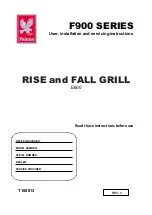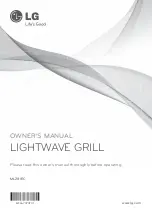
36
English
When the pressure is released, the liquid vaporises immediately and becomes fuel gas with 250% volu-
me.
• LPG has a similar smell to natural gas. You should be able to recognise that smell.
• Handle "empty" gas cylinders just as carefully as full ones. Even if there is no more liquid in the gas
cylinder, there may still be pressurised gas in the apparently empty gas cylinder.
Safetyinstructionsforgashoses
• Ensure that the
gas hose is uncovered
and
not near hot areas
. When the gas hose touches hot
areas, it may melt and leak.
• The gas hose may not be laid directly under the fat catcher tray.
• Avoid twisting the gas hose unnecessarily.
•
Before every start-up, check the screw fixings
of the gas hose connections are tight. If necessary,
tighten with two open-end spanners.
• Before
every use
, check the gas hose for
animal bites, cracks, porous areas, pinches, wear and
other damage.
Replace the gas hose immediately if damaged.
• Only approved gas hoses may be used.
• The maximum length of the gas hose must not exceed 1.5 metres.
• We recommend that you replace the gas hose of your gas grill every 5 years. In some countries it is
mandatory to replace the gas hose sooner. National regulations shall take precedence.
Safetyinstructionsforthegaspressureregulator
• Make sure that the gas pressure regulator is attached so that the small air outlet faces downwards and
no water can enter the hole. This air outlet must be kept clean and free of dirt, grease, insects, etc.
• No dirt may get into the gas pressure regulator or onto the screw fixing.
•
Before every start-up, check the screw fixings of the hose connection
are tight. If necessary,
tighten with two open-end spanners.
• Only approved pressure regulators that correspond to the national operating pressure may be used.
Obtain information from your dealer.
• In order to guarantee proper functioning of the gas pressure regulator in normal operating conditions,
it is recommended that you replace the gas pressure regulator prior to the end of 10 years after the
date of manufacture. Deviating national regulations shall take precedence.
Safetyinstructionsforstorage
•
Close the shut-off valve of the gas cylinder
every time when the
grill is not in use
in order to
avoid any leaks.
• Gas cylinders must be stored outdoors in a well-ventilated location and out of reach of children and
third-party access. Gas cylinders that have been removed may not be stored in buildings, garages or
other enclosed spaces.
Fuel gas is heavier than air. Escaping gas may collect in low level locations and not disperse. Therefore,
avoid entrances to basements, light shafts and water runoffs in order to avoid a fire or explosions.
• If the gas grill is stored in an enclosed space, the gas cylinder must be removed from the grill and
stored outdoors in a well-ventilated place.
• Nozzles, gas supply pipes and gas burners must be checked regularly for spider webs, insects, larva
cocoons and blockages by other factors.
















































